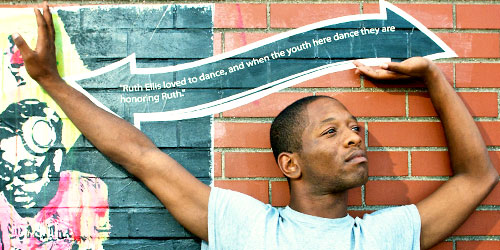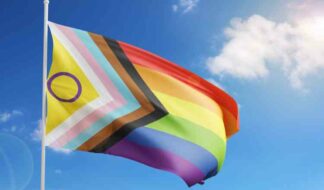by Jessica Carreras

Rafel Moore, a Ruth Ellis youth and voguer, strikes a pose outside of the drop-in center in Highland Park.
Kaleidoscope
6-11 p.m. Sept. 23
Scarab Club, 217 Farnsworth, Detroit
$125, or $50 for guests under 30
http://www.ruthelliscenter.com
On the brick exterior walls of the Ruth Ellis Center – named for one of the pioneers of Detroit's black, gay community – a painted mural features a very telling quote by center board member Kofi Adoma: "Ruth Ellis loved to dance, and when the youth here dance they are honoring Ruth."
At the Highland Park-based drop-in center for homeless or at-risk LGBT young adults, she is honored almost every day.
The term "vogue" conjures up images of pop superstar Madonna, striking a pose and the famous women's magazine after which the dance form's name is coined. In the LGBT community, we also know it to be a craze that has enraptured gay youth.
At the Ruth Ellis Center, in the lower level of Affirmations, in clubs, at any Pride festival – voguing is a staple. The high-energy music provides beats by which dancers – usually young, black gay men – dip, twirl, pose, catwalk and drop. They continue until some supervising adult tells them to stop. They pick it back up the next day. They dance through sprained wrists and sore muscles. They battle and catcall and cheer each other on. Ask a gay youth what his hobbies are and, more likely than not, the answer includes voguing.
But it's more than just dancing. Voguing and the culture that surrounds it can teach valuable skills, provide the support of a family, help to cope with stress. Sometimes, even save a life.
On Sept. 23 at Detroit's Scarab Club, the Ruth Ellis Center will present Kaleidoscope, an event designed to not only raise funds for the nonprofit organization, but to educate the community about voguing through a youth-focused documentary on the subject. And no one who attends will be able to say, "It's just dancing" ever again.
For Laura Hughes, learning about vogue and its importance to youth was part of her job when she came on board as Ruth Ellis Center's executive director just over a year ago.
"I am by no means an expert on any aspect of voguing," she admits. "It was an art form that was unfamiliar to me. When I first got to the center, I had heard from different community members, 'There's a lot of young people in there voguing all the time and that's all they're doing' – things like that."
But as Hughes watched the youth vogue and began to learn about the culture surrounding it – "houses" with family-like networks of dancers – she recognized it as a valuable tool to teach youth life skills. "This is something that young people love," she says. "This is something that young people already use for networks, so why can we not figure out a way to do educational programming and services for runaway and homeless youth that tie directly into this?"
Beyond providing a place for youth to dance (and, they comment, the drop-in center has beautiful hardwood flooring perfect for voguing), the REC has supplemented the pastime with history lessons about ballroom culture, classes to learn about other dance forms and now, the opportunity to create a documentary about their favorite activity.
The center teamed up with Diana Nucera from the Allied Media Project, an organization that teaches media creation and distribution skills to individuals and groups through projects much like the documentary that will be shown at Kaleidoscope.
Nucera worked with REC employee Frank Johnson and center youth Rafel Moore to create a film that would both showcase the beauty, creativity and talent involved with voguing and also tell the story underneath the art form: why it means so much to the youth who practice it.
"There's a lot of footage of voguing, but we really focused on the interview questions," Nucera explains, divulging that the video will include talks with both center youth and outsiders. "We spent most of our time coming up with these essential questions that would bring the story out about what voguing is and what it means here at the Ruth Ellis Center, but also there's a whole history and lifestyle behind it."
Adds Johnson: "We want viewers to know why voguers feel like it's so important to vogue or dance."
In the documentary, youth talk about what voguing means to them, what they've learned from dancing and what they think it tells the community about young LGBT people.
"Within the process of creating this video, it's revealed a lot about the community behind voguing and the culture behind it," Nucera says. "We wanted to prove that it's a viable dance form and it requires a lot of strength and endurance, but also style and sass and attitude. It really is a form of communication."
Hughes agrees, adding that for LGBT youth, who are often cast aside by both their families and society, dance is a way to show the world that they have value.
"At Ruth Ellis, how we look at our young people is that they are amazing young people," Hughes shares emphatically. "They may not be the most polished, they may not have the best communication skills, but they can get there. We really want to empower their voices, so we decided to use this opportunity to showcase the young people and showcase the work they're capable of doing."
But beyond the art and the skill, voguing and the culture that comes with it provides emotional nourishment and family structure that homeless youth lack.
"It's a family structure that comes out of when you don't have a family and you create a family that makes sense to your life," Nucera says. "If your life is not accepted in your birth family, I think that's where a lot of these structures come from, and voguing is like the glue that holds everything together."
Celebrating vogue culture makes perfect sense within the overall goal of the Ruth Ellis Center, too: providing structure, support and love for LGBT youth. And it helps, says Hughes, that the teens at the center are strong and resilient, with dreams for their future and the drive to take them there.
As such, creating the voguing documentary is expected to lead to more video productions from the youth about their lives, their passions and their hopes for becoming LGBT leaders. "I want everyone in this community to hear the voices of our young people and their experiences," Hughes says. "If documentaries on voguing, documentaries on where they live, documentaries on their family networks get that point out there, we as a community need to listen."










